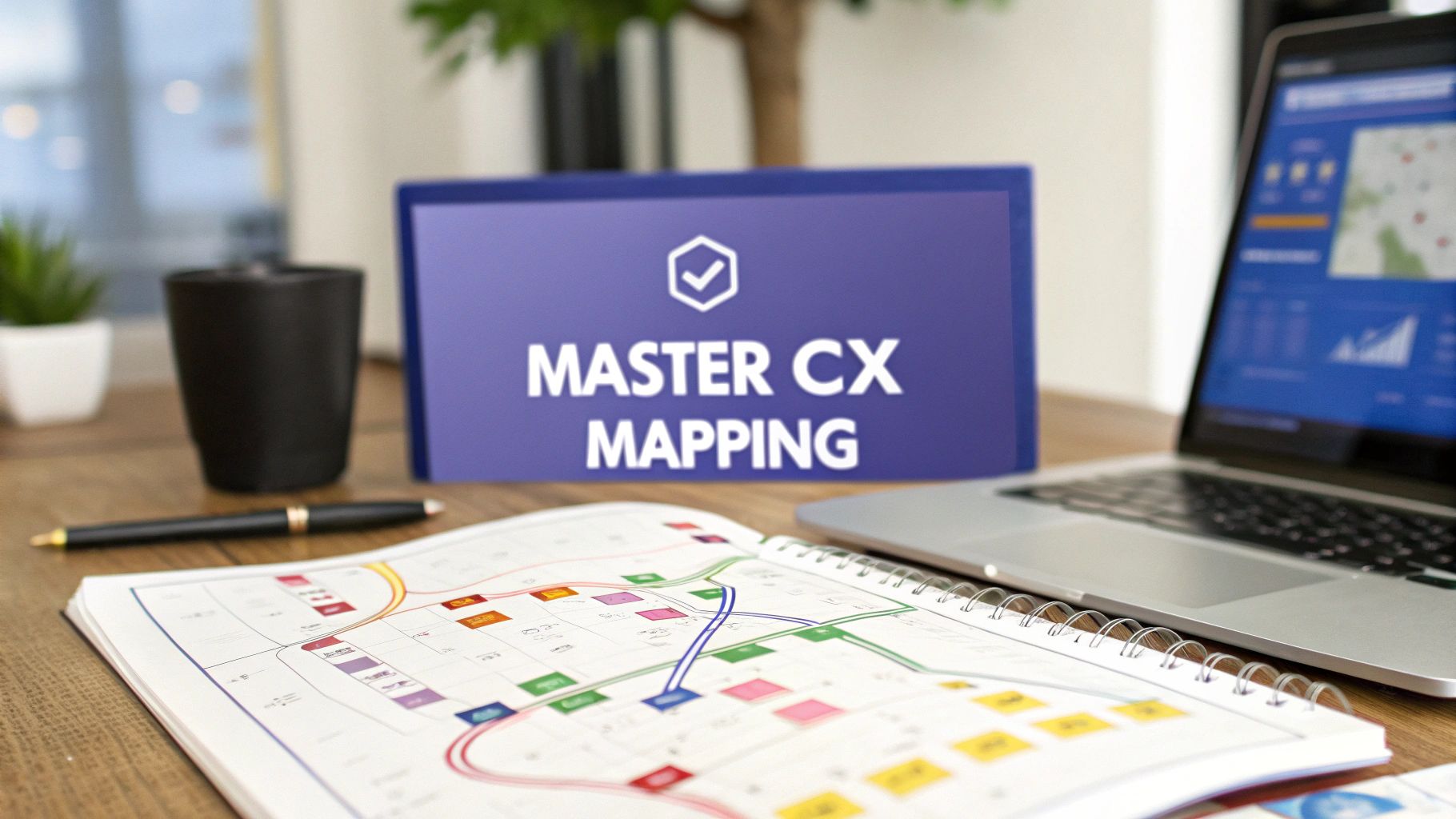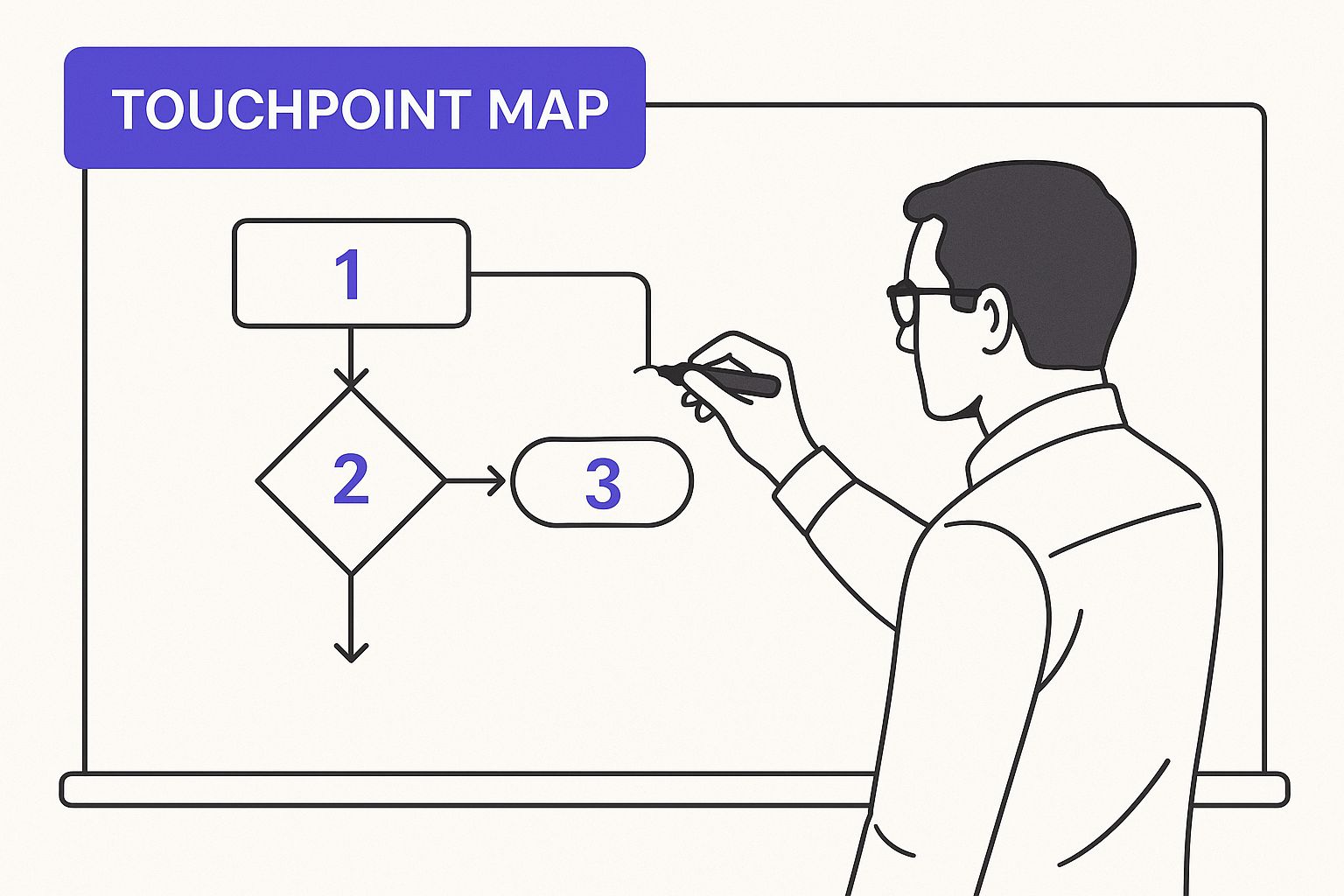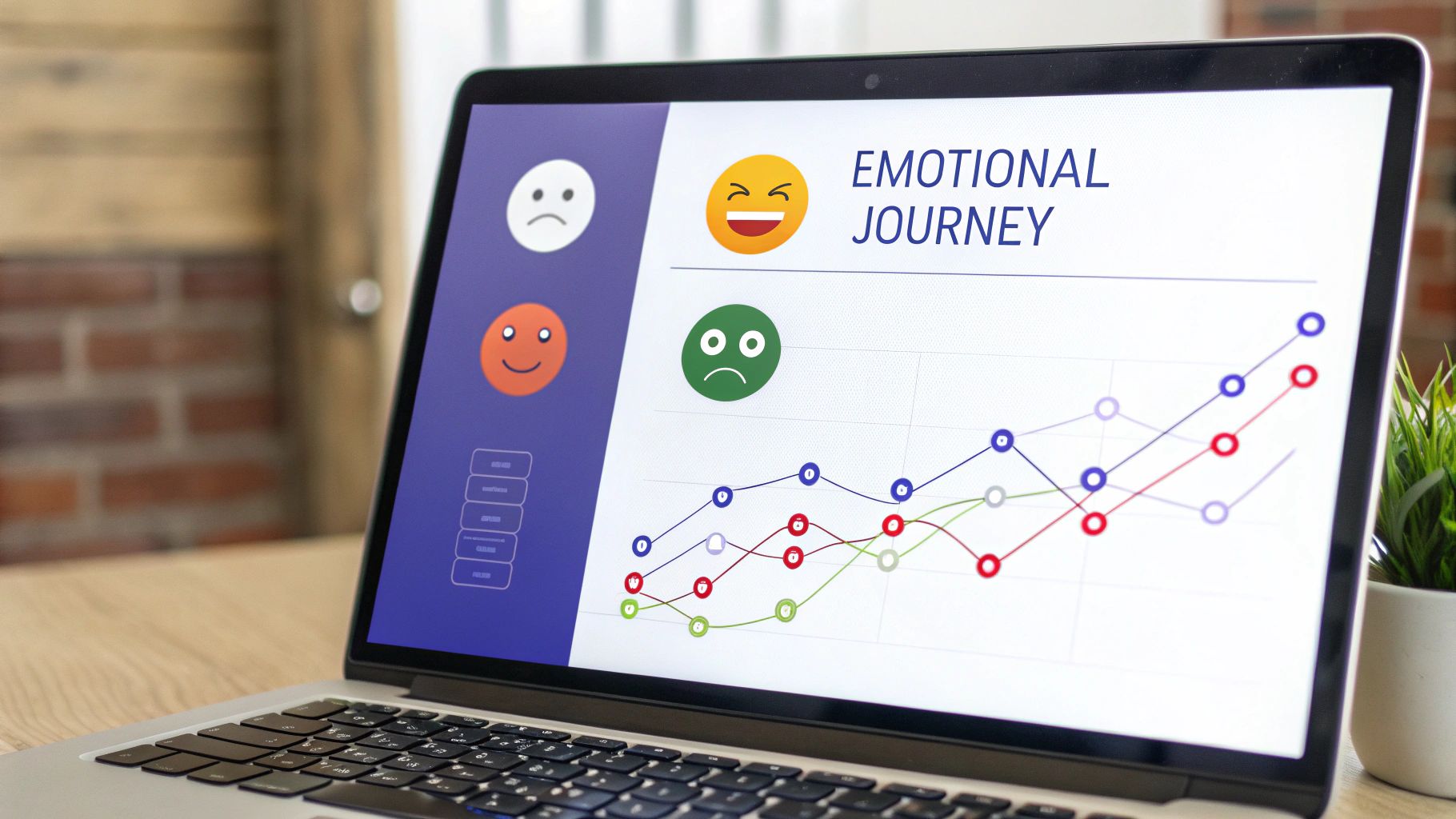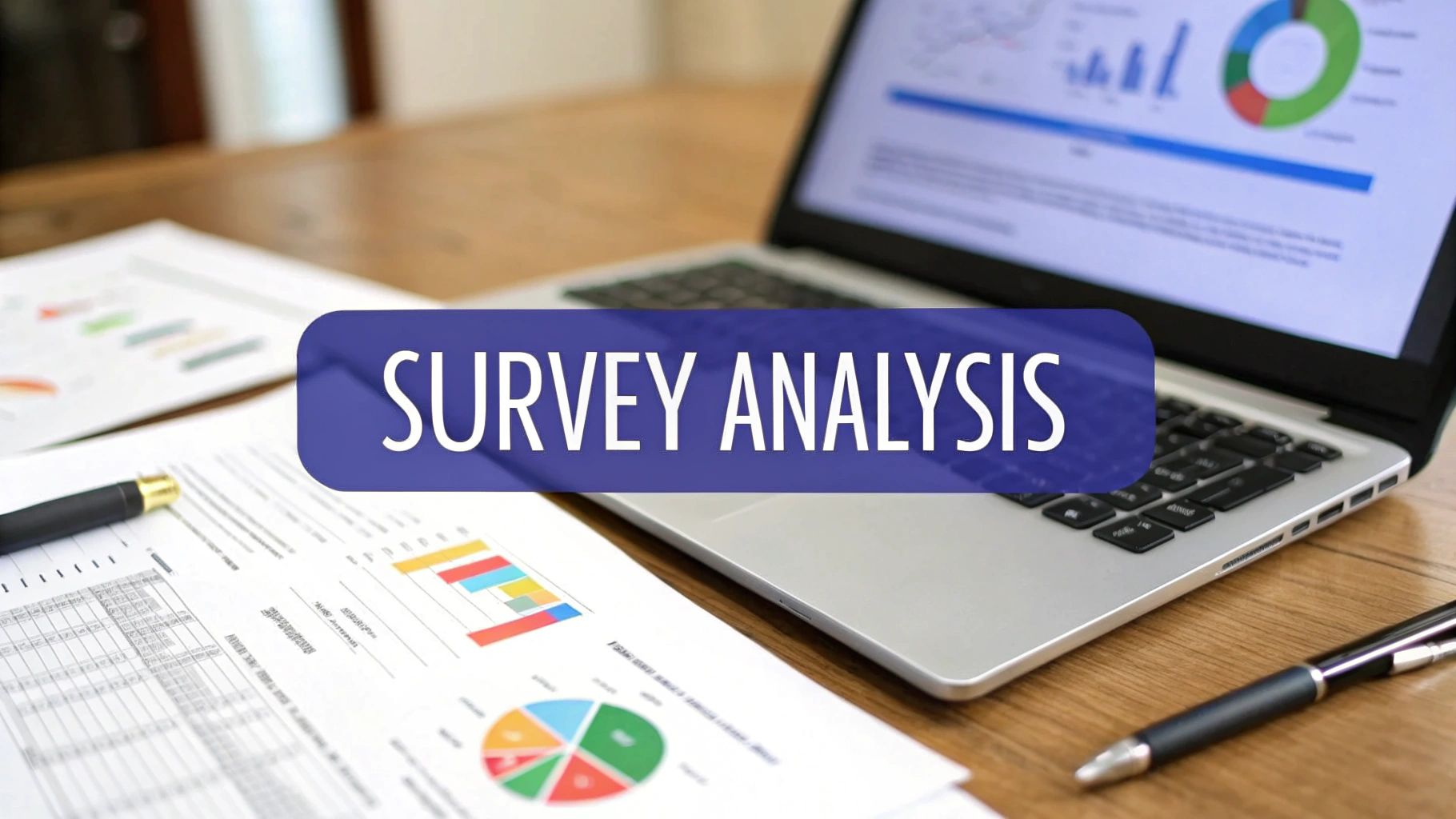Mastering Customer Experience Mapping
Transform your business with customer experience mapping. Learn how to visualize the customer journey, identify pain points, and create better experiences.

Customer experience mapping is the process of creating a visual story of every interaction a customer has with your company.
Think of it like drawing a map for a road trip. You are charting every step your customer takes, from the moment they first hear about you to becoming a long-time, happy user. It’s a strategic tool that gets your team to see the business through your customers' eyes, which is how you create experiences that build loyalty.
Understanding the Customer Experience Journey
A customer experience map is a diagram that shows the entire path a customer follows when engaging with your brand. It covers every stage, from initial awareness and research to making a purchase, using the product, and reaching out for support.
The goal is to capture what the customer thinks and feels at each touchpoint.
This process reveals important insights that often stay buried in departmental silos. For instance, your marketing team might celebrate a successful ad campaign, but the support team is dealing with a flood of calls from confused new customers. Mapping the full experience connects those dots, giving you the complete picture.
Why This Process Matters Now
In today's crowded market, getting inside your customer's head is fundamental to growth. Customer journey mapping has moved from a simple flowchart exercise into a dynamic, data-rich discipline that's important for survival.
With customer acquisition costs climbing to five times the cost of keeping an existing one, the ability to map and improve the end-to-end journey is a necessity. According to recent studies, CX leaders are doubling down and investing in journey mapping from Pathmonk.com.
This visual approach offers some big advantages, especially for SaaS companies:
- Better Customer Insight: It forces you to step directly into your customers' shoes, revealing their true motivations, biggest frustrations, and the small moments of delight that make all the difference.
- Promotes a Customer-Centric Culture: When every department, from sales and marketing to product and support, is looking at the same map, it aligns everyone around the shared goal of making the customer's life better.
- Pinpoints Friction: The map shines a bright light on exactly where customers are struggling, getting confused, or dropping off. This tells you precisely where to focus your efforts for the biggest impact.
The Strategic Value of Mapping
A customer experience map has the ability to turn vague customer feelings into a concrete business strategy. It helps your team move away from making assumptions about what customers want and make data-informed decisions based on their actual behavior. This shift in perspective is what separates good companies from great ones.
By visualizing the customer's journey, you find the gaps between the experience you think you're providing and the one customers are actually having. Closing these gaps is the key to building lasting loyalty and driving sustainable growth.
This approach allows you to pinpoint opportunities for improvement that can have a massive impact. For example, a map might reveal that your onboarding process is technically flawless but emotionally confusing for new users. That single insight could lead you to create better welcome emails or in-app guides that address those feelings head-on.
To appreciate the strategic payoff, it helps to learn how to master customer experience to drive profit. This is the first step toward building a more responsive and successful organization.
The Building Blocks of an Effective CX Map
To build a customer experience map that gives you real insights, you need to include the right components. Think of it like gathering ingredients before you start cooking. Without all the right pieces in place, the final result won't give you the clarity you need to make meaningful improvements.
Each component plays a specific role in telling the complete story of your customer's experience. When you combine them, you start to see a detailed, empathetic view of their entire relationship with your company, from start to finish.

So, what are these necessary ingredients? Let's walk through the core components you'll need to create a map that’s both comprehensive and actionable.
Table: Essential Elements of a Customer Experience Map
By having each of these elements represented, your map transforms from a simple flowchart into a powerful strategic tool. Now let's look at each one.
H3: Customer Personas
The first and most important building block is the customer persona. This is a fictional profile that represents your ideal or most common type of customer. A good persona goes beyond simple demographics; it brings your customer to life with real goals, motivations, and frustrations.
You cannot map a journey without knowing who is taking it. It's also why you'll often create different maps for different personas, as a new user will have a completely different experience than a seasoned power user.
H3: Journey Stages
Next, you need to define the stages of the customer's journey. These are the major phases a customer moves through as their relationship with your brand evolves. While the exact stages can vary from business to business, they typically follow a logical progression from initial contact to long-term loyalty.
For a SaaS business, the stages often look something like this:
- Awareness: The moment a customer first learns your product exists.
- Consideration: They start evaluating your solution against their needs and your competitors.
- Decision (or Purchase): They make the commitment to buy or sign up.
- Onboarding & Use: They learn how to use the product to solve their problem.
- Retention & Advocacy: They become loyal users and hopefully start recommending your product to others.
H3: Customer Touchpoints
Within each stage, you have touchpoints, the specific points of interaction between the customer and your company. This is where the customer "touches" your brand, and mapping these out is key to seeing where the experience is actually happening.
For instance, during the "Consideration" stage, a touchpoint might be reading one of your blog posts, watching a demo video, or hopping on a call with your sales team. Identifying every single one is important for getting a complete picture.
A customer experience map reveals every single interaction, no matter how small. In these moments, loyalty is either built or broken. Knowing the full collection of touchpoints is the only way to manage the experience effectively.
H3: Actions, Thoughts, and Emotions
This is where the map gains its depth and becomes a tool for empathy. For each touchpoint, you need to document what the customer is doing, thinking, and feeling.
- Actions: What is the customer physically doing? (e.g., clicking a button, filling out a form, talking to support).
- Thoughts: What questions or ideas are running through their mind? (e.g., "Is this worth the price?" "This seems complicated." "Where do I find the settings?").
- Emotions: How are they feeling in that moment? (e.g., confused, excited, frustrated, relieved).
Capturing this information almost always requires direct feedback from your users. You can gather these insights by analyzing a voice of the customer survey, conducting user interviews, or combing through support tickets.
H3: Pain Points and Opportunities
Finally, your map should clearly highlight the pain points and opportunities at each stage. Pain points are the frustrations, roadblocks, and obstacles that make the customer's experience difficult. For every single pain point, there's an opportunity for you to improve.
If customers consistently feel frustrated during onboarding (a pain point), you have a great opportunity to simplify the process with better in-app guides or clearer instructions. This final component is what turns your customer experience map from a simple diagram into an actionable plan for improvement.
How to Create Your Customer Experience Map
Putting together a customer experience map is more of a science than an art. It's a structured process that takes raw customer data and turns it into a clear, visual story about their journey with your brand. Think of it as methodically piecing together their actions, thoughts, and feelings to build the complete picture.
Following a clear set of steps makes this process manageable and means the final map is useful, not just a pretty diagram. This guide will walk you through five key actions to create your own map from the ground up. By working through each one, you can turn a complex idea into a practical tool for your business.
Step 1: Set Clear Objectives
Before you think about mapping, you need to know why you're doing it. What specific business goal will this map help you achieve? Without a clear objective, your map can easily become a collection of interesting but unusable information.
Your goals need to be specific and measurable. For example, a vague goal like "improve the customer experience" won't work. Aim for something more concrete:
- Reduce churn during the first 30 days of onboarding.
- Increase the conversion rate on our pricing page.
- Pinpoint friction points in our customer support process to lower ticket volume.
Setting a clear goal from the start focuses your efforts and gives you a way to measure success later on. It defines the scope of your map and ties the entire project to a real business outcome.
Step 2: Develop Detailed Customer Personas
You can't map a journey without knowing who's taking it. That's where customer personas come in. These are detailed, data-driven profiles of your target customers, brought to life with their own goals, motivations, and challenges.
A strong persona is built on real data, not guesswork. Dig into information from:
- Customer surveys and feedback forms.
- Interviews with your sales and support teams (they're on the front lines).
- Website and product analytics.
For instance, a SaaS company might create "Startup Steve," a founder who needs a simple, scalable tool, and "Enterprise Emily," a department head who requires robust security features and integrations. Their journeys with your product will be completely different, which is why creating these distinct personas is an important first step.
Step 3: Identify All Customer Touchpoints
Next, you need to list every single point where a customer interacts with your company. These touchpoints are the individual moments that, strung together, make up the entire journey. Get your team in a room (or on a call) and brainstorm every possible interaction, no matter how small it seems.
This is where you start sketching out the skeleton of your map.

As you can see, mapping these touchpoints creates a blueprint for the complete customer experience. Touchpoints span every stage, from that first moment of awareness to long-term advocacy. A touchpoint could be seeing a social media ad, reading a blog post, using a specific product feature, or even receiving an invoice.
Step 4: Gather Customer Feedback and Data
With your personas and touchpoints defined, it’s time to bring your map to life with real data. This is where you find out what customers are actually doing, thinking, and feeling at each step.
You'll want to pull information from a variety of sources:
- Surveys: Send targeted surveys to different customer segments to ask about their experiences at specific touchpoints.
- User Interviews: A one-on-one conversation is great for getting deeper, qualitative insights into their motivations and frustrations.
- Analytics: Use your website and product analytics to see where users are clicking, spending time, and dropping off. The numbers don't lie.
- Support Tickets: Your customer support conversations are a goldmine for finding common questions and complaints.
This mix of quantitative ("what") and qualitative ("why") data provides the evidence you need to build a map that's both accurate and empathetic. To help structure this part of the project, you might find it helpful to start with a customer journey mapping template.
Step 5: Visualize the Journey and Analyze Your Findings
The final step is to pull all your research together into a visual map. This visualization should plot out the journey stages, touchpoints, and the customer's actions, thoughts, and emotions for each persona. The format can be as simple as a flowchart on a whiteboard or a more detailed diagram created with specialized software.
Once the map is visualized, your team can analyze it to spot key patterns and insights. Look for the moments with a high concentration of negative emotions or where customer actions don't line up with the path you want them to take.
The real goal of the visualization is to pinpoint the biggest pain points and, more importantly, the most promising opportunities. A well-constructed map will clearly show you where a small change could make a big difference in the overall customer experience.
For example, your map might reveal that customers feel anxious during the payment process. That single insight could lead you to add trust badges or simplify the checkout form, directly addressing their emotional state and improving conversions. To see how others have effectively visualized these steps, it's incredibly valuable to review practical customer journey map examples.
Common Mapping Mistakes and How to Avoid Them
You’ve just finished creating a customer experience map, and it feels like a huge win. But if it’s built on a shaky foundation, it’s not much more than a pretty poster for the office wall. It happens all the time: companies pour time and resources into mapping, only to end up with a final product that doesn't deliver any real results.
By getting ahead of the common pitfalls, you can build a map that’s accurate, effective, and a true reflection of your customer’s reality. Avoiding these mistakes is the difference between creating a powerful strategic tool and wasting a lot of effort.

Assuming You Know Your Customers
This is, without a doubt, the single biggest mistake you can make. It's building a map based on what you think you know, not what you actually know. Teams often believe they have a handle on their customers, but without hearing it straight from the source, they’re just guessing. This inside-out approach almost always misses the real frustrations and motivations that drive customer behavior.
An entire map built on assumptions is fundamentally flawed. It ends up reflecting the company’s internal biases, not the customer’s actual experience.
The Solution: You have to talk to your customers. Your map needs to be built on a foundation of real, hard data. Get out there and collect it.
- User Interviews: Sit down for one-on-one conversations. This is where you’ll get the deep, qualitative insights you can’t find anywhere else.
- Surveys: Send out targeted surveys to collect quantitative feedback at key moments in their journey.
- Support Tickets: Your support logs are a goldmine. Dig through them to find recurring pain points and common questions.
- Analytics: Look at user behavior data. See what people are actually doing, not just what they say they’re doing.
Mapping Only the "Happy Path"
It’s tempting to map out the perfect journey, isn't it? The one where a customer sees an ad, signs up seamlessly, loves the product instantly, and becomes a lifelong advocate. While this "happy path" is a nice goal, it completely ignores the messy reality of most customer experiences.
The truth is, customers hit roadblocks. They get confused. They take weird, unexpected detours. A map that only shows the best-case scenario is useless for identifying the friction points that are probably costing you customers.
A great customer experience map celebrates what works and investigates what's broken. The most valuable insights come from exploring the detours and dead ends, not just the smooth highway.
Treating the Map as a One-Time Project
Another classic blunder is treating the map as a "set it and forget it" task. A team spends weeks creating a beautiful, detailed map, presents it to leadership, and then files it away. Meanwhile, the business evolves, customer expectations shift, and the map quickly becomes an outdated relic.
Your customer's journey isn't static. It changes every time you update your product, launch a new marketing campaign, or tweak your support process.
The Solution: Think of your map as a living document. Schedule regular check-ins, maybe quarterly or bi-annually, to update it with fresh data and new insights. Every time you launch a major feature or change your onboarding flow, pull out the map and see how it impacts the overall journey.
Lacking Clear Ownership and Action
Even a perfectly researched, beautifully designed map is worthless if no one is responsible for acting on what it reveals. The map might expose a massive pain point in the billing process, but if it’s not clear who owns that problem, nothing is going to change.
This lack of follow-through is surprisingly common. While 91% of businesses aim to be customer experience leaders, many fall short when it comes to connecting insights with action. In fact, 88% of CX decision-makers know customization is key, yet they often lack the resources to improve their digital journeys. You can discover more insights about customer journey statistics on llcbuddy.com.
To avoid this, make sure you assign clear ownership for each stage of the journey. Give those teams the ability to make changes and hold them accountable for improving the experience based on what the map tells you.
Choosing the Right Tools for Your CX Map
While there's nothing wrong with a whiteboard and sticky notes to get started, the right software can seriously level up your customer experience mapping. Dedicated tools help you build, manage, and share your maps with more detail and collaboration than a physical board ever could.
Picking the right platform comes down to your team's needs, budget, and how complex the journey you're mapping is.
The tools out there today are more powerful than ever. The global customer journey mapping market is exploding, largely thanks to advancements in analytics and AI. Valued at $5.6 billion back in 2020, it's projected to hit $15.8 billion by 2025. Companies using these tools are seeing up to a 25% boost in customer satisfaction. You can discover more predictions about AI in CX on superagi.com.
Let's break down the different kinds of tools to help you find the perfect fit.
Digital Whiteboarding and Collaboration Tools
Think of these as the digital version of your whiteboard. They give you a flexible canvas for brainstorming, sketching out rough ideas, and working with your team in real time. They're perfect for the early stages of mapping when you're just trying to get all your ideas out and start giving them some structure.
These platforms are very visual and intuitive, which makes them great for getting people from different departments involved, no matter their tech skills.
- Miro: An infinite digital whiteboard that lets teams brainstorm, build diagrams, and map out journeys together. It's a lifesaver for workshops and remote teams.
- Mural: Similar to Miro, Mural is all about visual collaboration. It comes loaded with templates and frameworks designed specifically for brainstorming and planning sessions.
Best for: Teams of any size who need a flexible, collaborative space for those initial brainstorming and mapping workshops. They're especially handy for remote or hybrid teams.
Dedicated Journey Mapping Software
Once you're ready to move past brainstorming and create detailed, data-rich maps, it's time to call in the specialists. Dedicated software is built specifically for customer experience mapping and is packed with features to make the whole process more structured and insightful.
They often include persona builders, touchpoint libraries, and the ability to link data and customer feedback directly to points on your map.
These specialized tools transform your map from a static diagram into a dynamic, living document. They let you track emotions, link to data sources, and share an interactive version of the customer journey across your organization.
Popular options include:
- Smaply: A purpose-built platform for creating detailed customer journey maps, personas, and stakeholder maps. It helps you visualize even the most complex journeys with precision.
- UXPressia: Offers a suite of tools for creating professional-looking journey maps, personas, and impact maps. It includes great features for tracking customer emotions and flagging pain points.
Best for: Businesses that are serious about customer experience mapping and need a powerful tool to create, manage, and share detailed maps. They're a fantastic choice for product, marketing, and customer success teams.
Analytics and Feedback Platforms
Your map is only as good as the data you build it on. Analytics and feedback platforms provide the raw ingredients you need to create an accurate, evidence-based map. These tools help you gather both quantitative data (the what) and qualitative data (the why).
To make the most of this information, you can pull all your findings into a central customer experience dashboard for a single, unified view. These platforms are necessary for checking the assumptions you made during mapping and for measuring the real impact of any changes you roll out.
- Google Analytics: Gives you priceless quantitative data on user behavior, like where your traffic comes from, what pages people view, and how they move through your conversion funnels.
- Hotjar: Offers heatmaps, session recordings, and on-site surveys to give you a visual look at how users actually interact with your website. It's like looking over their shoulder.
- Surva.ai: A powerful tool for getting direct customer feedback through targeted surveys. It helps you capture the thoughts and emotions that raw numbers alone can never tell you.
Got Questions About CX Mapping?
Even with a great plan, a few questions always pop up when you first start customer experience mapping. Think of this as your quick-reference guide to clear up some of the most common head-scratchers. We’ll tackle a few key topics to make sure you have everything you need to move forward with confidence.
Getting these common questions out of the way first helps you avoid simple mistakes and makes your mapping efforts much more effective right from the get-go.
Customer Experience Map vs. Customer Journey Map: What’s the Difference?
This is easily the most common question I hear. People often use customer experience map and customer journey map interchangeably, and honestly, that’s usually fine. They’re talking about the same core idea and are very closely related.
But if you want to get technical, there’s a subtle difference. A customer journey map usually focuses on the specific steps a customer takes to hit a single goal, like buying a product or starting a free trial. It's often linear and focused on actions.
A customer experience map, on the other hand, can be much broader. It tries to capture the entire universe of a customer's feelings and perceptions across every single interaction they could possibly have with your company over time. It’s less about one specific path and more about the overall relationship.
The key takeaway? Don't get hung up on the terminology. Both tools are designed to force you to see your business through your customer's eyes. Focus on that goal, and you'll be on the right track.
How Often Should I Update My CX Map?
Another big question is about the shelf life of a customer experience map. It’s a huge mistake to treat your map like a one-and-done project that gets filed away in a dusty digital folder. Your business isn't static, and your customers definitely aren't.
Your customer experience map should be a living document. It needs to be pulled out and updated regularly to stay relevant and useful. A good rule of thumb is to give it a thorough review at least once or twice a year.
But you should also pull it out anytime something significant changes. This could be things like:
- Launching a new product or a major feature: This adds new touchpoints and interactions to the customer's world.
- Changing your pricing model: A shift in pricing can completely change a customer's emotions and decisions, especially early on.
- Seeing a surge of new feedback: If you spot a new pattern in support tickets or survey answers, it’s time to figure out where that fits into the map.
- Watching the market shift: New competitors or different customer expectations can make your old map obsolete overnight.
What's the Single Biggest Benefit of Mapping?
While CX mapping delivers many wins, from spotting pain points to boosting conversions, its single greatest benefit is its power to get the entire organization aligned around the customer.
In most companies, departments live in their own little worlds. Marketing is all about leads, sales is focused on closing deals, and support is trying to clear tickets. Each team has its own goals, its own metrics, and often a very narrow view of the customer's reality. This creates a choppy, frustrating, and disjointed experience for the person who actually pays the bills.
A customer experience map shatters those silos.
When everyone, from the CEO to the new support agent, can see the same visual story of the customer's journey, it creates a shared language and a collective understanding. It forces every single team to see how their little piece of the puzzle impacts the customer and contributes to the bigger picture. That alignment is the secret ingredient to building a truly customer-obsessed culture.
Can a Small Business Really Benefit from This?
It’s easy to assume customer experience mapping is a complex, expensive process only for big corporations with dedicated CX teams and massive budgets. That couldn't be further from the truth. The core ideas of mapping are incredibly scalable and are just as valuable for a small business or scrappy startup.
In fact, small businesses often have a huge advantage. They’re usually much closer to their customers and can get feedback more directly. A small team can literally gather around a whiteboard and sketch out the entire core journey in a single afternoon.
The map doesn’t have to be a fancy, multi-layered digital masterpiece. It can be a simple flowchart drawn on a piece of paper. What really matters is the act of stepping into your customer's shoes and thinking critically about their experience from their point of view.
For a small business, a CX map helps you:
- Prioritize your limited resources: Pinpoint the handful of changes that will make the biggest difference to customer happiness.
- Keep things consistent: Make sure every customer gets an amazing experience, even as your team starts to grow.
- Build a loyal following: Create the kind of positive, memorable experiences that fuel word-of-mouth referrals, the lifeblood of any growing business.
Ready to turn customer feedback into your biggest growth driver? At Surva.ai, we provide AI-powered survey tools designed for SaaS businesses to reduce churn, collect powerful testimonials, and get actionable insights from your users. Start understanding your customers better today.


